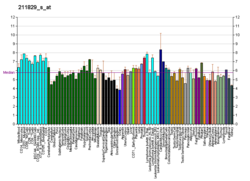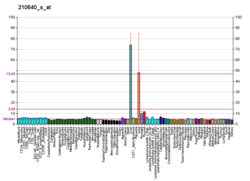GPER
گیرندهٔ ۱ استروژن جفتشونده با پروتئین جی (انگلیسی: G protein-coupled estrogen receptor 1) یا به اختصار «GPER» که با نام «گیرندهٔ ۳۰ جفتشونده با پروتئین جی» (GPR30) هم شناخته میشود، یک پروتئین است که در انسان توسط ژن «GPER» کُدگذاری میشود.[۴] این گیرنده با اتصال به هورمون جنسی استرادیول فعال شده و مسئولِ بروزِ برخی از اثرات فوریِ غیر ژنومی این هورمون در سلولهاست. جایگاه این گیرنده در غشاء سلولی است اما بیشتر در شبکه آندوپلاسمی قابل ردیابی است.[۵][۶]
لیگاند[ویرایش]
این گیرنده تنها به استرادیول اتصال مییابد و سایر استروژنهای درونزاد نظیر استرون، استریول یا سایر استروئیدهای درونزاد مثل پروژسترون، تستوسترون و کورتیزول نمیتوانند به آن وصل شوند.[۷][۸][۹][۱۰] با آنکه این گیرنده بهطور بالقوه در پیامدهی آلدوسترون نقش دارد، اما هیچگونه اتصال قابل توجهی با آلدوسترون ندارد.[۱۱][۱۲] نیاسین و نیکوتینامید در محیطهای کشت تمایل اتصالیِ بسیار ضعیفی با این گیرنده دارند.[۱۳][۱۴] سیتوکین CCL18 یک آنتاگونیست درونزاد برای گیرندهٔ GPER است.[۱۵]
عملکرد[ویرایش]
این گیرنده، عضوی از خانوادهٔ گیرندههای جفتشونده با پروتئین جی شبه رودوپسین است که در غشاء سلولی جای دارد. در اثرِ اتصال به استرادیول، این گیرنده سبب تحرک یونهای کلسیم درونسلولی و ساخت مادهٔ فسفاتیدیلاینوزیتول (۳٬۴٬۵) تریفسفات در هستهٔ سلول میشود[۷] که نتیجهٔ آن پیامدهی (سیگنالینگ) غیر ژنومی و فوری در بافتهاست.[۱۶] در جوندگان، بیشترین میزانِ این پروتئین در هیپوتالاموس، هیپوفیز، مغز غده فوق کلیوی، مغز کلیه و فولیکولهای تخمدان مشاهده شدهاست.[۱۷]
اهمیت در سرطان[ویرایش]
اگرچه در آغاز تصور میکردند که پیامدهی این گیرنده در رشد تومور در سرطان پستان نقش دارد،[۱۸] اما پژوهشها و بررسیهای بعدی نشان داد که پیامدهی استروژنهای غیرکلاسیک در واقع خاصیت ضدسرطانی (سرکوبکنندگی) در پستان دارند.[۱۹][۲۰][۲۱] همچنین این گیرندهٔ خاصیت سرکوبکنندگی تومور در سرطان روده بزرگ،[۲۲] سرطان مخاط رحم،[۲۳] تومور سلول لایدیگ[۲۴] (نوع خاصی از سرطان بیضه و سرطان تخمدان)، سرطان ریه از نوع غیرِ سلولِ کوچک،[۲۵] سرطان معده،[۲۶] سرطان کبد،[۲۷] ملانوما،[۲۸] استئوسارکوما،[۲۹] سرطان تخمدان[۳۰] و سرطان پروستات[۳۱] را داراست.
جستارهای وابسته[ویرایش]
منابع[ویرایش]
- ↑ ۱٫۰ ۱٫۱ ۱٫۲ GRCm38: Ensembl release 89: ENSMUSG00000053647 - Ensembl, May 2017
- ↑ "Human PubMed Reference:". National Center for Biotechnology Information, U.S. National Library of Medicine.
- ↑ "Mouse PubMed Reference:". National Center for Biotechnology Information, U.S. National Library of Medicine.
- ↑ O'Dowd BF, Nguyen T, Marchese A, Cheng R, Lynch KR, Heng HH, Kolakowski LF, George SR (Jan 1998). "Discovery of three novel G-protein-coupled receptor genes". Genomics. 47 (2): 310–3. doi:10.1006/geno.1998.5095. PMID 9479505.
- ↑ Revankar CM, Cimino DF, Sklar LA, Arterburn JB, Prossnitz ER (March 2005). "A transmembrane intracellular estrogen receptor mediates rapid cell signaling". Science. 307 (5715): 1625–30. doi:10.1126/science.1106943. PMID 15705806.
- ↑ Vrtačnik P, Ostanek B, Mencej-Bedrač S, Marc J (2014). "The many faces of estrogen signaling". Biochemia Medica. 24 (3): 329–42. doi:10.11613/BM.2014.035. PMC 4210253. PMID 25351351.
- ↑ ۷٫۰ ۷٫۱ Revankar CM, Cimino DF, Sklar LA, Arterburn JB, Prossnitz ER (March 2005). "A transmembrane intracellular estrogen receptor mediates rapid cell signaling". Science. 307 (5715): 1625–30. doi:10.1126/science.1106943. PMID 15705806.
- ↑ Filardo EJ, Thomas P (October 2005). "GPR30: a seven-transmembrane-spanning estrogen receptor that triggers EGF release". Trends in Endocrinology and Metabolism. 16 (8): 362–7. doi:10.1016/j.tem.2005.08.005. PMID 16125968.
- ↑ Manavathi B, Kumar R (June 2006). "Steering estrogen signals from the plasma membrane to the nucleus: two sides of the coin". Journal of Cellular Physiology. 207 (3): 594–604. doi:10.1002/jcp.20551. PMID 16270355.
- ↑ Prossnitz ER, Arterburn JB, Sklar LA (February 2007). "GPR30: A G protein-coupled receptor for estrogen". Molecular and Cellular Endocrinology. 265–266: 138–42. doi:10.1016/j.mce.2006.12.010. PMC 1847610. PMID 17222505.
- ↑ Wendler A, Albrecht C, Wehling M (August 2012). "Nongenomic actions of aldosterone and progesterone revisited". Steroids. 77 (10): 1002–6. doi:10.1016/j.steroids.2011.12.023. PMID 22285849.
- ↑ Cheng SB, Dong J, Pang Y, LaRocca J, Hixon M, Thomas P, Filardo EJ (February 2014). "Anatomical location and redistribution of G protein-coupled estrogen receptor-1 during the estrus cycle in mouse kidney and specific binding to estrogens but not aldosterone". Molecular and Cellular Endocrinology. 382 (2): 950–9. doi:10.1016/j.mce.2013.11.005. PMID 24239983.
- ↑ Santolla MF, De Francesco EM, Lappano R, Rosano C, Abonante S, Maggiolini M (July 2014). "Niacin activates the G protein estrogen receptor (GPER)-mediated signalling". Cell. Signal. 26 (7): 1466–1475. doi:10.1016/j.cellsig.2014.03.011. PMID 24662263.
Nicotinic acid, also known as niacin, is the water soluble vitamin B3 used for decades for the treatment of dyslipidemic diseases. Its action is mainly mediated by the G protein-coupled receptor (GPR) 109A; however, certain regulatory effects on lipid levels occur in a GPR109A-independent manner. The amide form of nicotinic acid, named nicotinamide, acts as a vitamin although neither activates the GPR109A nor exhibits the pharmacological properties of nicotinic acid. In the present study, we demonstrate for the first time that nicotinic acid and nicotinamide bind to and activate the GPER-mediated signalling in breast cancer cells and cancer-associated fibroblasts (CAFs)
- ↑ Barton M (February 2016). "Not lost in translation: Emerging clinical importance of the G protein-coupled estrogen receptor GPER". Steroids. 111: 37–45. doi:10.1016/j.steroids.2016.02.016. PMID 26921679.
- ↑ Catusse J, Wollner S, Leick M, Schröttner P, Schraufstätter I, Burger M (November 2010). "Attenuation of CXCR4 responses by CCL18 in acute lymphocytic leukemia B cells". J. Cell. Physiol. 225 (3): 792–800. doi:10.1002/jcp.22284. PMID 20568229.
- ↑ "Entrez Gene: GPR30 G protein-coupled receptor 30".
- ↑ Hazell GG, Yao ST, Roper JA, Prossnitz ER, O'Carroll AM, Lolait SJ (August 2009). "Localisation of GPR30, a novel G protein-coupled oestrogen receptor, suggests multiple functions in rodent brain and peripheral tissues". The Journal of Endocrinology. 202 (2): 223–36. doi:10.1677/JOE-09-0066. PMC 2710976. PMID 19420011.
- ↑ Lappano R, Pisano A, Maggiolini M (2014). "GPER Function in Breast Cancer: An Overview". Frontiers in Endocrinology. 5: 66. doi:10.3389/fendo.2014.00066. PMC 4018520. PMID 24834064.
- ↑ Wei W, Chen ZJ, Zhang KS, Yang XL, Wu YM, Chen XH, et al. (October 2014). "The activation of G protein-coupled receptor 30 (GPR30) inhibits proliferation of estrogen receptor-negative breast cancer cells in vitro and in vivo". Cell Death & Disease. 5 (10): e1428. doi:10.1038/cddis.2014.398. PMC 4649509. PMID 25275589.
- ↑ Weißenborn C, Ignatov T, Ochel HJ, Costa SD, Zenclussen AC, Ignatova Z, Ignatov A (May 2014). "GPER functions as a tumor suppressor in triple-negative breast cancer cells". Journal of Cancer Research and Clinical Oncology. 140 (5): 713–23. doi:10.1007/s00432-014-1620-8. PMID 24553912.
- ↑ Weißenborn C, Ignatov T, Poehlmann A, Wege AK, Costa SD, Zenclussen AC, Ignatov A (April 2014). "GPER functions as a tumor suppressor in MCF-7 and SK-BR-3 breast cancer cells". Journal of Cancer Research and Clinical Oncology. 140 (4): 663–71. doi:10.1007/s00432-014-1598-2. PMID 24515910.
- ↑ Liu Q, Chen Z, Jiang G, Zhou Y, Yang X, Huang H, et al. (May 2017). "Epigenetic down regulation of G protein-coupled estrogen receptor (GPER) functions as a tumor suppressor in colorectal cancer". Molecular Cancer. 16 (1): 87. doi:10.1186/s12943-017-0654-3. PMID 28476123.
- ↑ Skrzypczak M, Schüler S, Lattrich C, Ignatov A, Ortmann O, Treeck O (November 2013). "G protein-coupled estrogen receptor (GPER) expression in endometrial adenocarcinoma and effect of agonist G-1 on growth of endometrial adenocarcinoma cell lines". Steroids. 78 (11): 1087–91. doi:10.1016/j.steroids.2013.07.007. PMID 23921077.
- ↑ Chimento A, Casaburi I, Bartucci M, Patrizii M, Dattilo R, Avena P, et al. (August 2013). "Selective GPER activation decreases proliferation and activates apoptosis in tumor Leydig cells". Cell Death & Disease. 4 (8): e747. doi:10.1038/cddis.2013.275. PMID 23907461.
- ↑ Zhu G, Huang Y, Wu C, Wei D, Shi Y (August 2016). "Activation of G-Protein-Coupled Estrogen Receptor Inhibits the Migration of Human Nonsmall Cell Lung Cancer Cells via IKK-β/NF-κB Signals". DNA and Cell Biology. 35 (8): 434–42. doi:10.1089/dna.2016.3235. PMID 27082459.
- ↑ Tian S, Zhan N, Li R, Dong W (April 2019). "Downregulation of G Protein-Coupled Estrogen Receptor (GPER) is Associated with Reduced Prognosis in Patients with Gastric Cancer". Medical Science Monitor. 25: 3115–3126. doi:10.12659/MSM.913634. PMC 6503750. PMID 31028714.
- ↑ Wei T, Chen W, Wen L, Zhang J, Zhang Q, Yang J, et al. (November 2016). "G protein-coupled estrogen receptor deficiency accelerates liver tumorigenesis by enhancing inflammation and fibrosis". Cancer Letters. 382 (2): 195–202. doi:10.1016/j.canlet.2016.08.012. PMID 27594673.
- ↑ Ribeiro MP, Santos AE, Custódio JB (November 2017). "The activation of the G protein-coupled estrogen receptor (GPER) inhibits the proliferation of mouse melanoma K1735-M2 cells". Chemico-Biological Interactions. 277: 176–184. doi:10.1016/j.cbi.2017.09.017. PMID 28947257.
- ↑ Wang Z, Chen X, Zhao Y, Jin Y, Zheng J (January 2019). "G-protein-coupled estrogen receptor suppresses the migration of osteosarcoma cells via post-translational regulation of Snail". Journal of Cancer Research and Clinical Oncology. 145 (1): 87–96. doi:10.1007/s00432-018-2768-4. PMID 30341688.
- ↑ Ignatov T, Modl S, Thulig M, Weißenborn C, Treeck O, Ortmann O, et al. (July 2013). "GPER-1 acts as a tumor suppressor in ovarian cancer". Journal of Ovarian Research. 6 (1): 51. doi:10.1186/1757-2215-6-51. PMID 23849542.
- ↑ Lam HM, Ouyang B, Chen J, Ying J, Wang J, Wu CL, et al. (2014). "Targeting GPR30 with G-1: a new therapeutic target for castration-resistant prostate cancer". Endocrine-Related Cancer. 21 (6): 903–14. doi:10.1530/ERC-14-0402. PMID 25287069.
- مشارکتکنندگان ویکیپدیا. «GPER». در دانشنامهٔ ویکیپدیای انگلیسی، بازبینیشده در ۲۶ مارس ۲۰۲۰.
پیوند به بیرون[ویرایش]
- GPER protein در سرعنوانهای موضوعی پزشکی (MeSH) در کتابخانهٔ ملی پزشکی ایالات متحدهٔ آمریکا




